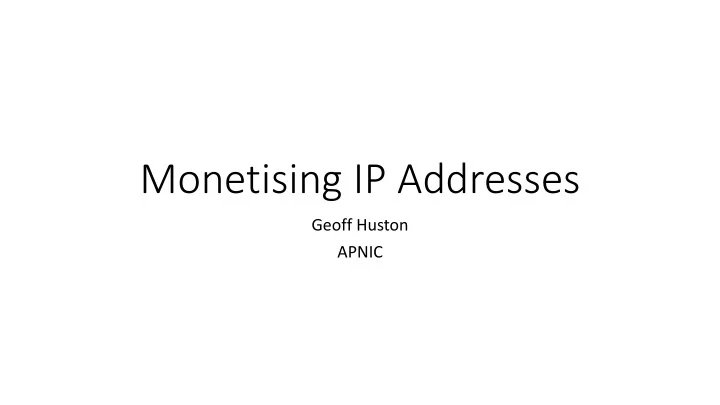

Monetising IP Addresses Geoff Huston APNIC
Addresses are not Property • The original view of IP addresses is that they were merely enabling tokens to access the common Internet network • The critical resource was the network – addresses were mere identification tokens without intrinsic value • Address blocks were allocated to entities on the basis of: • Unhindered availability (free) • First come first served • In perpetuity • Address “security” was largely non-existent • The registry whois service provided little in the way of practical security • Hijacking of an unused addresses was largely ignored
“Free” Addresses Consequences: • Free availability supressed the formation of any form of secondary market in addresses • Continued free availability provided no natural incentives for efficient utilisation, and no incentive to counter hoarding, which exacerbated consumption • The finite resource pool could not withstand infinite demand • But we recognised all this 30 years ago and forecast the result
“Internet Growth” Frank Solensky, Proc. IETF, Aug 1990
Public Good Economics How should we distribute a finite public good? • Rationing • Allocate a fixed amount to each consumer • Leads to random outcomes through over and under allocation, and a secondary redistribution market • Auctions • Provide incentives to the most efficient exploitation model that applies a maximum exploitative value to the resource • Does not necessarily cater to fairness or common beneficial public outcomes • Pricing • Either outright purchase (freehold) or leasehold • Price setting in the absence of a market often leads to distortions, particularly if the price is not aligned to market expectations
Addresses are still not Property • RIR Model – Rationing and Pricing • Conservative consumption principles • Deliberately designed to constrain demand pressures • Attempted to prevent the creation of an aftermarket in addresses • Consequences • Development of policies by incumbent address holders ran the risk of creating self-perpetuation of advantage held by early adopters • Was the large scale use of NATs in mobile environments an unforced decision or an outcome of a constrained position by a late market entrant?
Exhaustion
IPv4 Exhaustion
Address Transfers All RIRs Transfers Xfers Addresses 1000 20000000 900 18000000 800 16000000 700 14000000 600 12000000 500 10000000 400 8000000 300 6000000 200 4000000 100 2000000 0 0 2009-10 2010-03 2010-08 2011-01 2011-06 2011-11 2012-04 2012-09 2013-02 2013-07 2013-12 2014-05 2014-10 2015-03 2015-08 2016-01 2016-06 2016-11 2017-04 2017-09 2018-02 2018-07 2018-12 2019-05 2019-10
Market Behaviour https://lassekarstensen.wordpress.com/2019/01/03/some-ipv4-address-price-forecasting/ http://ipv4marketgroup.com/ipv4-price-trends/
What just happened? • The network lost its dependence on unique addressing as a universal host identification token • The architecture of the network is now fully client/server • The application layer has subsumed the service identification function • There is no significant escalation in scarcity pressure on addresses
Observations • Did masking a scarcity premium in IPv4 address pricing stall the V6 transition? • We didn’t need V6 and still don’t need V6 • By the time we run out of V4 we will have outgrown V6 • The IMEI / Sim is the endpoint identity space of the future network
Recommend
More recommend